Sanda
| Sanda | |
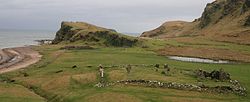 St Ninian's Chapel, Sanda | |
|---|---|
| Location | |
| Location: | 55°16’48"N, 5°34’48"W |
| Grid reference: | NR730043 |
| Area: | 314 acres |
| Highest point: | 404 feet (123 m) |
| Data | |
Sanda is a small privately owned island in Argyllshire, off the southern tip of the Kintyre peninsula, near Southend and Dunaverty Castle.
Sanda can be seen from the southern tip of the Kintyre peninsula and from the Isle of Arran on clear days. It is known locally on Arran as "Spoon Island"[1] because of its resemblance to an upturned spoon when viewed from the South coast of the island.
The name of the island is Norse: Sand ey, meaning "Sand(y) Island", a name shared with numerous isles of the Hebrides and Orkney named "Sanday"
Population

In the 2001 census, Sanda was one of four Hebridean islands with a population of one person. However, since then there has been some development, and in 2008 the island had a population of 3.[2] In August 2008 the island was put up for sale by the husband and wife owners as a result of their separation at a price of £3.2 million, and in January 2009 they announced that a sole caretaker would be resident until spring viewings re-commenced.[3] The island finally sold to Swiss businessman Michi Meier for the lower price of £2.5 million.
The island's growth as a tourist destination may come to an end under the new owner who has stated that he wants the island for personal use.[4] By 2011 it had no usual residents at the time of the 2011 census.
Wildlife
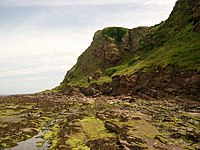
The island is designated a Site of Special Scientific Interest for its importance for both migrating and breeding birds.[5]
The island is currently treeless, however, Wood Hill in the north west provides a tantalising clue that this was not always the case.[6]
Geography and geology
According to Haswell-Smith, the island's geology is "lower old red sandstone in red and yellow varieties, and undifferentiated schists." [6]
Sanda lies in the North Channel between Great Britain and Ireland. It is part of a mini-archipelago to the southeast of the Mull of Kintyre, at the far end of the Firth of Clyde, of which the other islands are Glunimore and Sheep Island, to the northeast. Between them, in the shallower water, is Oitir Buidhe, meaning the "yellow strand", which probably lends the island its name. To the east there is also the notorious "ship catcher", Paterson's Reef.[6]
The island has cliffs on most sides. There are caves on the west coast, and also a couple of natural arches, particularly near "the Ship" as the lighthouse is nicknamed. There are two main hills, in the northwest and southeast. In between them is a valley which has the double advantage of being sheltered from the prevailing winds and catching the heat of the sun.[6]
History
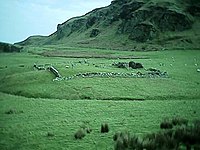
The island has connections with several well-known historical personages, including the Bruce family, Wallace and St Ninian, the first evangelist in these remote parts.
The island is known for the ruins of a chapel built by St Ninian, for its Celtic crosses and its reputed holy well.[7] It is said that Ninian was buried here, and indeed, the island was in possession of the Priory of Whithorn in Galloway until the Reformation. A grim local legend had it that Ninian's grave was marked by an alder tree, and that whoever stepped on it would die.[6]
The name 'sandy island' may refer to the Oitir Buidhe which lies between Sanda and Glunimore and Sheep Island. Another name that appears to have attached itself to the island is Havoin (and numerous variants such as "Aven", "Avona"), which was recorded amongst the "Danish" by Dean Monro in his 16th century Description of the Western Isles of Scotland. This is cognate with the English "haven (to refer to the anchorage on the north coast) or 'hav' meaning "sea".
In the Middle Ages, there was some association with the Bruce family, notably, Robert the Bruce who fought his way to the crown, and his brother Edward. Edward lends his name to "Prince Edward's Rock", which is just south of Sanda Lighthouse. Robert was once forced to flee there, on the way to Ireland after being pursued by the English navy. He has been sheltering with sympathisers at nearby Dunaverty Castle, on Kintyre in 1306, but was forced to leave. He later sheltered at Rathlin Island, which is less than fifteen miles away, and which is where he was said to have seen the legendary spider in the cave.[6] In the south are "Wallace's Rocks" which may be linked in legend to William Wallace.
In the later 16th and 17th centuries, the island was connected with the MacDonalds of Kintyre, who sided with Montrose ("Bonnie Dundee"/"Bluidy Clavers") Colkitto married a MacDonald of Sanda;[8] those MacDonalds were also caught up in related fighting from the 1630s onwards, and lost their position as a result of the Dunaverty Massacre.[9]
The island has had a number of different owners in its history, including, in 1969, Jack Bruce of the rock group Cream.
About the island
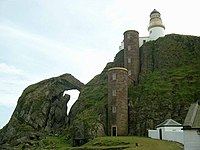
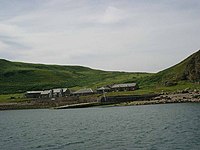
Lighthouse
At the southern tip of the island is a lighthouse built in 1850 by Alan Stevenson. When seen from the sea to the south, the natural arch, and the lighthouse on the rock can look like a ship, hence its name "The Ship" on marine charts.
Byron Darnton
A pub was opened in 2003, named Byron Darnton after the vessel which wrecked on the island in 1946. The Byron Darnton was named after an American war correspondent whose son, John Darnton, also became a journalist and wrote of his visit to the island in 2005.
Stamps
Local postage stamps have been issued for Sanda since 1962. The stamps served the resident staff employed by the Northern Lighthouse Board, the owners and the many visitors to the island who wished to have their mail posted there, and carried to the nearest GPO post box on the mainland.[10]
Outside links
| ("Wikimedia Commons" has material about Sanda Island) |
- Photographers website (Project on Sanda)
- Sanda Island
- Sanda Lighthouse
- Sanda Island Bird Observatory
References
- ↑ "Isle of Arran". Internet Guide to Scotland. http://www.scotland-inverness.co.uk/arran.htm#kildonan. Retrieved 7 October 2009.
- ↑ "Sanda Island". sanda-island.co.uk. Archived from the original on August 4, 2008. http://web.archive.org/web/20080804010440/http://www.sanda-island.co.uk/level_one/welcome.html. Retrieved 7 January 2009.
- ↑ "Lone laird guards remote island". The Scotsman (Edinburgh). 7 January 2009.
- ↑ "Tiny island group sells for £2.5m". BBC News. 27 March 2010. http://news.bbc.co.uk/1/hi/scotland/glasgow_and_west/8590687.stm.
- ↑ "Sanda Island Bird Observatory". http://www.spanglefish.com/sandaislandbirdobservatory. Retrieved 7 October 2009.
- ↑ 6.0 6.1 6.2 6.3 6.4 6.5 Haswell-Smith, Hamish (2004). The Scottish Islands. Edinburgh: Canongate. ISBN 1841954543.
- ↑ Reeves, William, 'On the Island of Sanda', paper read before the Royal Irish Academy on April 14, 1862 (Dublin: 1862) title at google.com
- ↑ "MacDonald05". http://stirnet.com/HTML/genie/british/mac/macdonald05.htm. Retrieved 30 December 2009.; but there are other theories.
- ↑ Alastair Henderson (30 April 1998). "Sanda". Kintyre Antiquarian & Natural History Society. http://www.kintyremag.co.uk/1998/16/page4.html. Retrieved 7 October 2009.
- ↑ "Modern British Local Posts CD Catalogue, 2009 Edition". Phillips. 2003. http://www.seahorsepublishers.com/phillipscatalogues.htm. Retrieved 8 December 2008.
Coordinates: 55°16′55″N 5°35′1″W / 55.28194°N 5.58361°W
